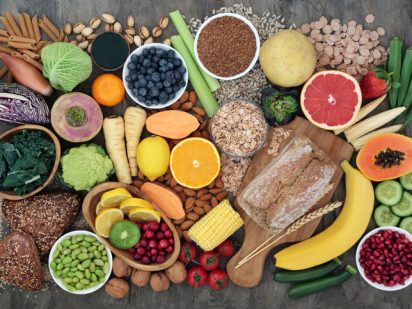Kayla Benson, Clinical Dietitian, Trinity Health
Dietary fiber is the part of plant foods that the body cannot absorb or breakdown, which many refer to as “roughage.” There are two types of dietary fiber: soluble and insoluble. Soluble fiber is dissolvable in water, forms a gel-like substance, adds bulk to your stool and is the type of fiber that can help lower cholesterol and blood sugar levels. Types of soluble fiber include peas, beans, apples, oats and barley. Insoluble fiber promotes the movement of stool through the intestines and is less soluble in water which helps aid in relieving constipation. Types of insoluble fiber include whole wheat, nuts and many vegetables. A great example of visible dietary fiber is the stringy portion of celery.
The many benefits of fiber
Dietary fiber has gained a lot of popularity over the years. When strolling the grocery store aisles many famous products now have labels promoting the fiber content of the item. One may ask, “if fiber is not digested in the body, how can it be so beneficial?” One reason is that insoluble fiber interacts and binds with fatty acids and cholesterol within the digestive tract, which results in less absorption. Adequate intake of fiber also helps slow the absorption of glucose and therefore stabilizes blood sugar. Research has shown fiber boosts your mood and energy, along with helping you feel fuller for longer periods of time which can help with weight loss. Fiber consumption also decreases the chance of hemorrhoids and constipation. Your digestive tract has “good” and “bad” bacteria. Certain fiber can promote the growth of the good bacteria and can decrease the risk of getting certain types of infections, diseases and cancers, especially colon cancer.
Recommendations and Tips
The recommend daily value for adults is 28 grams based on a 2,000-calorie diet. It is estimated that the average adult consumes less than 15 grams of fiber per day.
If you decide to increase dietary fiber into your diet, there are two important tips you need to remember:
- Add fiber gradually. If you’ve been consuming less fiber than what is recommended for your age, do not start eating the full amount right away. It is best to gradually increase fiber to your goal amount because fiber can cause bloating, gas, upset stomach and even diarrhea or constipation if your digestive system is not used to an abundance.
- Drink plenty of fluids. Drinking water helps fiber do its job. Remember with adequate fiber and water, your stool will have more bulk and move through your intestines easier, which eases constipation and promotes bowel regulation.
- Fiber consumption is beneficial to maintain the integrity of your digestive tract. When looking at food labels aim for foods with at least three grams of fiber per serving. Here are a few high fiber recipes that are a couple of my favorites.
Cranberry Walnut Oatmeal
(serves 4 with 5g fiber/serving)
1 cup steel-cut oats (regular oats work too) 1⁄4 cup sweetened dried cranberries
1⁄4 tsp. ground cinnamon
2 cups water
4 tsp. chopped walnuts
4 tsp. packed brown sugar
In a saucepan, combine the oats, cranberries, cinnamon and water. Bring to a boil over high heat, then reduce the heat to low and simmer, uncovered, until the oats are tender, about 20 minutes.
Spoon the oatmeal into warmed individual bowls and sprinkle each serving with 1 tsp. each of walnuts and brown sugar.
Southwestern Chicken and Pasta
(serves 4 with 5g fiber/serving)
1 cup uncooked whole-wheat rigatoni
2 boneless, skinless chicken breasts, cut into cubes 1⁄4 cup salsa
1 1⁄2 cups canned unsalted tomato sauce
1⁄4 tsp. garlic powder
1 tsp. cumin
1⁄2 tsp. chili powder
1⁄2 cup canned black beans, rinsed and drained
1⁄2 cup fresh or canned corn
1⁄4 cup shredded cheese
Fill a large pot 3⁄4 full of water and bring to boil. Add the pasta and cook until tender. Drain the pasta thoroughly. Spray a large, heavy skillet with cooking spray. Over medium heat, sauté the chicken until brown and opaque throughout. Stir in the salsa, tomato sauce, garlic powder, cumin, chili powder, black beans and corn. Stir thoroughly and cook until heated through. Add the pasta and gently toss to mix evenly. Sprinkle with cheese and serve.
Recipes found at: www.mayoclinic.com

